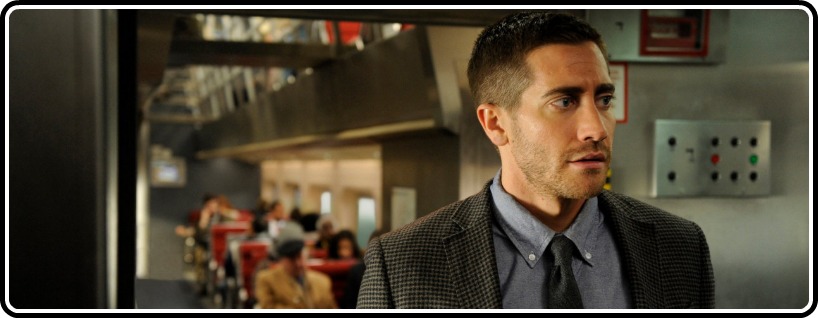Did you know that life is precious? Did you know that you should make every minute count? If you didn’t, Source Code is going to make sure you do. What starts out as a very tight and tense high concept science-fiction film eventually becomes a parable that bashes its message over our heads. The conclusion leaves an irreparably bitter taste in the mouth, made worse because the first two thirds of Source Code happen to be tremendously entertaining and absorbing.
Captain Colter Stevens (Jake Gyllenhaal) finds himself on a Chicago train in the body of a man named Sean Fentress. A woman sitting across from him named Christina (Michelle Monaghan) engages him in conversation. Eight minutes later, the train blows up and Colter wakes up inside of a chamber where a military officer named Colleen Goodwin (Vera Farmiga) appears on a screen and asks him if he has found the bomber. Not being able to find out any information about his own situation, he is told that he is inside a program called the Source Code. This allows someone from a narrow set of qualifications to enter the last eight minutes of a person’s life, in this case Sean Fentress. Fentress was on a Chicago train which, that morning, exploded with no survivors. Goodwin and Dr. Rutledge (Jeffrey Wright) want Colter to use the source code to find out who the bomber is before the next anticipated attack takes place.
Source Code is structurally tight at ninety three minutes and creates equal intrigue between its two main settings. By having a mystery as the driving force both in and out of the source code, there is no lapse in interest. In the source code, Colter has to find the bomber. Outside of the source code, he has to figure out what has happened to him, where he is and why he is there. The revelations outside the source code bring additional layers of intensity to Colter’s time on the train.
Ben Ripley, who wrote the screenplay, knows exactly when to reveal certain information, spreading out the explanations and exposition evenly and effectively. It is consistently intriguing as it unfolds, even when certain reveals are somewhat predictable. Overall, this is an effective screenplay that works with a traditional structure to deliver on its inventive premise. Getting to see Colter’s succession of attempts within the source code allows for a wide array of situations, each building on the next. There are a lot of wonderful action sequences and tension wrung from each successive effort.
As strong as a lot of Ripley’s screenplay is, a skilled director is necessary to rein in the more inadequate aspects of the story. With characters that border on undeveloped and a more than familiar bomber scenario, Ripley’s strengths could have easily been drowned out by the story’s potential weak spots. Duncan Jones brings an attention to detail, making the most out of each scenario and the different ways we see the various attempts unfold. Jones is controlled and keeps a clear priority on the actors’ faces amidst the action, which helps add to the characterization that is somewhat absent or one note from the dialogue. A strong sophomore effort, the director proves for the second time he can excel in this genre. All the actors are satisfactory except Wright, who is tonally off, creating an over the top caricature that belongs in a different film entirely.
The climax is passed over quickly and compactly, revealing other hidden agendas. It turns out that the bomber plotline is really just an excuse to examine how people take time for granted. Colter understands this because of his mission, and thus so does the audience. He is able to experience firsthand a dire situation that forces him to make the most of his time. The message the film wants to get across is already implicit within the story. There is no need for specific dialogue that refers again and again to making life count. This sentiment is more than valuable, but not when it takes over the film entirely by the end with tactlessness both in visuals and dialogue.
In addition, the film goes to inordinate lengths to ensure an ending that allows moviegoers to leave the theater satisfied. The resolution of Source Code goes on for far too long in order to give the ending audiences assumedly want. This desperate and misguidedly elaborate setup becomes distracting, making the ending unearned and ineffective. Combined with the resolution’s incessant need to cornily illustrate the film’s message, the last third all but ruins the first two thirds.
It is those first two thirds though, that make Source Code worth seeing. The film delivers more often than not. The action is wholly satisfying because the premise allows the rare treat of seeing a situation played out in a number of different ways. It ever so slightly recalls the multiple lives in a video game or reading a Choose Your Own Adventure book, without ever evoking either of these examples enough to distract. Source Code‘s glaringly transparent final act may not destroy everything that came before it, but it unfortunately leaves an irremovable taint on what is otherwise a worthwhile time at the movies.






![Bergman Island (The Criterion Collection) [Blu-ray]](https://criterioncast.com/wp-content/uploads/2022/11/bergman-island-the-criterion-collection-blu-ray-400x496.jpg)
![This Is Not a Burial, It’s a Resurrection (The Criterion Collection) [Blu-ray]](https://criterioncast.com/wp-content/uploads/2022/11/this-is-not-a-burial-its-a-resurrection-the-criterion-collection-blu-ray-400x496.jpg)
![Lars von Trier's Europe Trilogy (The Criterion Collection) [The Element of Crime/Epidemic/Europa] [Blu-ray]](https://criterioncast.com/wp-content/uploads/2022/11/lars-von-triers-europe-trilogy-the-criterion-collection-the-element-of-400x496.jpg)
![Imitation of Life (The Criterion Collection) [Blu-ray]](https://criterioncast.com/wp-content/uploads/2022/11/imitation-of-life-the-criterion-collection-blu-ray-400x496.jpg)
![The Adventures of Baron Munchausen (The Criterion Collection) [4K UHD]](https://criterioncast.com/wp-content/uploads/2022/11/the-adventures-of-baron-munchausen-the-criterion-collection-4k-uhd-400x496.jpg)
![Cooley High [Criterion Collection] [Blu-ray] [1975]](https://criterioncast.com/wp-content/uploads/2022/11/cooley-high-criterion-collection-blu-ray-1975-400x496.jpg)